Back to: setae
Forward to: legs
Spinnerets
The spinnerets are a group of four setae or setal clusters at the end of the epiproct:
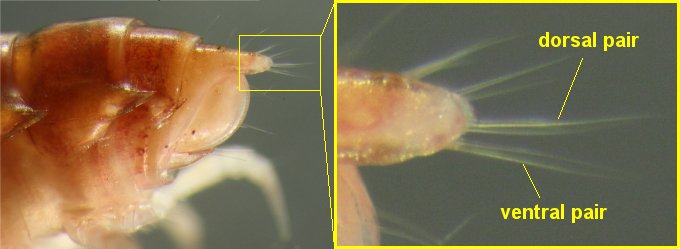
Lissodesmus perporosus (Dalodesmidae), Tasmania
The late Joachim Adis and colleagues (2000) showed that these setae secrete a silk-like substance in juveniles of two species of Pyrgodesmidae. The secreted substance is a mucopolysaccharide, not a fibrous protein as in true arthropod silk. It is secreted from a sleeve surrounding the base of each seta.
The secretion seems to be used for lining the soil chambers that juveniles build when they get ready to moult. 'Silk' use in other Polydesmida has not yet been carefully studied. Do the spinnerets act as outlets for 'silk' in adults? No one knows, but adults do have spinnerets.
Bill Shear (2008) used scanning electron microscopy to examine spinnerets in 23 genera of Polydesmida scattered across 18 families. He found that:
Arrangements vary; in most species the spinnerets are at the corners of a quadrangle which may be nearly square, rectangular, or trapezoidal. The spinnerets may or may not be set in special walled depressions, which may include all four spinnerets, or surround individual depressions for each spinneret. The spinnerets themselves closely resemble ordinary setae, except for noticeably larger sockets. The spinneret setae often have at their base sleeve-like extensions of the socket floor, and there may be both inner and outer sleeves. In some cases, pores may be detected between the inner and outer sleeves, or between the wall of the enclosing depression and the socket itself. While the majority of spinnerets have only single setae in each socket, in some cases as many as four to six setae arise from the same socket. The setae do not appear in themselves to be highly specialized, having smooth shafts and lacking any obvious pores. To the extent that the modified sockets and sleeves were missing, the spinnerets may be vestigial or at least not functional as such.
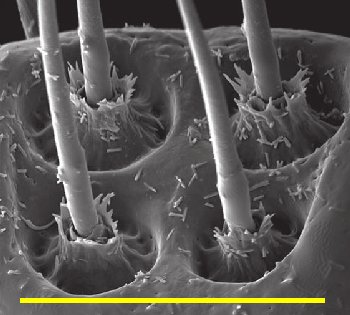 |
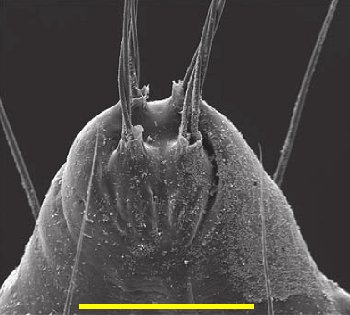 |
Pseudopolydesmus canadensis (Polydesmidae) |
Katantodesmus sp. (Oniscodesmidae) |
Images courtesy W.A. Shear; scale bars = 0.1 mm. The P. canadensis spinnerets (left) are each deeply recessed in a low-walled chamber, and the sleeve at the base of each seta has an irregularly toothed margin. In Katantodesmus sp. (right), each sleeve holds 2 setae and only the ventral spinnerets are in a (shared) depression.
Spinneret variations may be useful in future for classifying Polydesmida. In Tasmania, I found (Mesibov 2009) that one particular group of genera in the suborder Dalodesmidea has the ventral pair of spinnerets spaced further apart than the dorsal pair (below, left), while in all other Tasmanian Dalodesmidea so far investigated the four spinnerets are in a rectangular array (below, right).
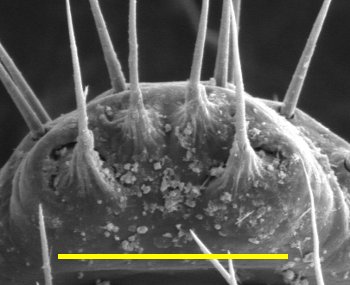 |
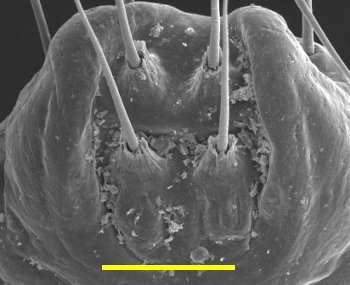 |
Noteremus infimus (family uncertain) |
Tasmanopeltis grandis (Dalodesmidae) |
Scale bars = 0.1 mm
The recently discovered Dobrodesmus mirabilis, a Brazilian cave species, has 2 rather than 4 spinnerets (Shear et al. 2016).
Adis, J., Hansen, B., Wilck, L., Adis, I. and Hirschel, K. 2000. A spinning apparatus documented in Polydesmida for the first time. Fragmenta Faunistica Supplement 43: 139–148.
Mesibov, R. 2009. A new millipede genus and a new species of Asphalidesmus Silvestri, 1910 (Diplopoda: Polydesmida: Dalodesmidea) from southern Tasmania, Australia. ZooKeys 7: 55-74.
Shear, W. A. 2008. Spinnerets in the milliped order Polydesmida, and the phylogenetic significance of spinnerets in millipeds (Diplopoda). International Journal of Myriapodology 2: 123–146.
Shear, W.A., Ferreira, R.L., Iniesta, L.F.M. and Marek, P. 2016. A millipede missing link: Dobrodesmidae, a remarkable new polydesmidan millipede family from Brazil with supernumerary rings (Diplopoda, Polydesmida), and the establishment of a new suborder Dobrodesmidea. Zootaxa 4178(3): 371-390.
Back to: setae
Forward to: legs
